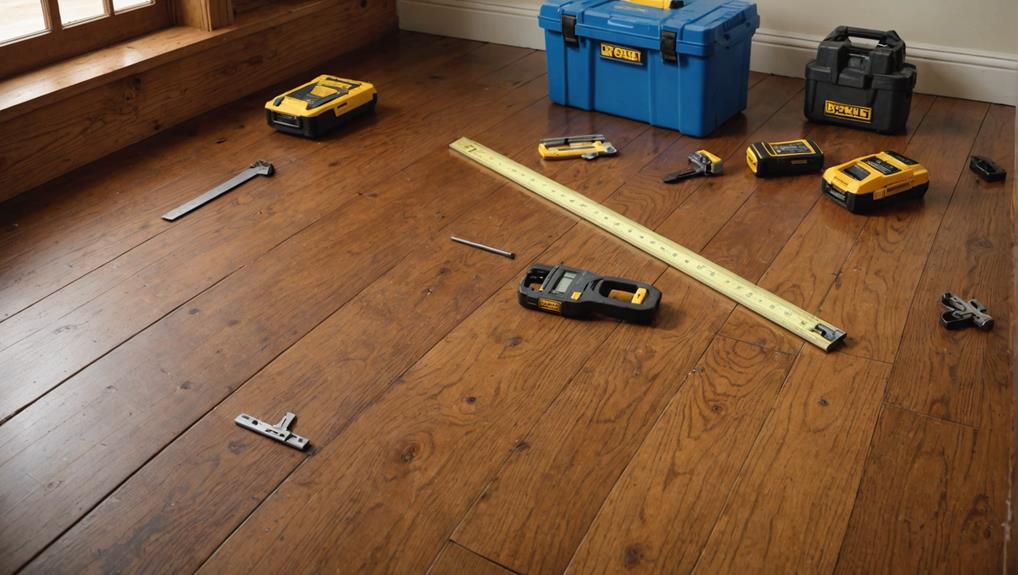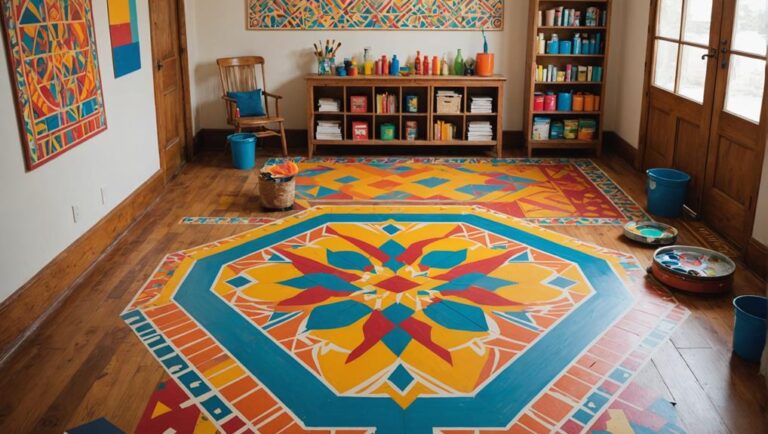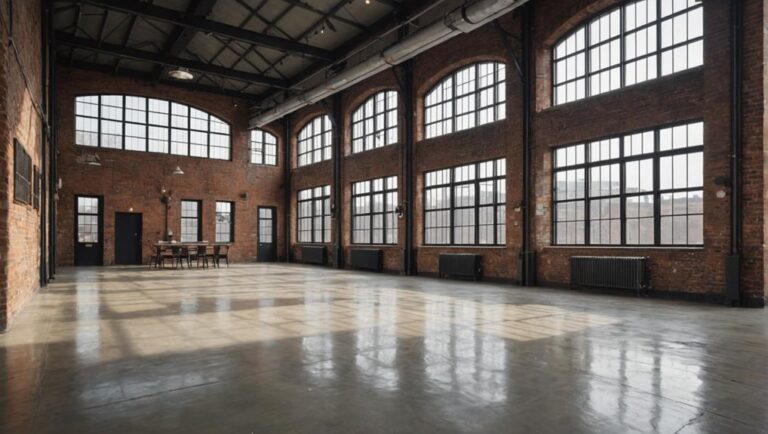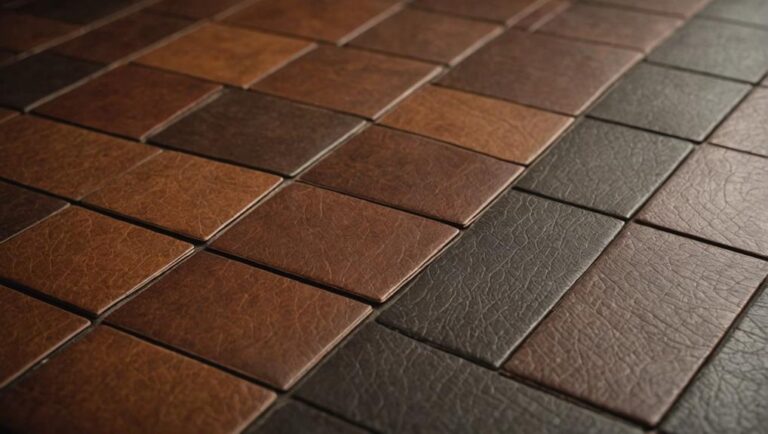To deal with buckled hardwood floors, first identify the cause, often related to excess moisture or humidity fluctuations. Control indoor humidity levels between 30%-50% using dehumidifiers or humidifiers as needed. Inspect the affected areas for warping, gaps, or creaking, and assess whether repairs or replacements are necessary. For minor damage, sanding and refinishing may suffice, while extensive issues often require professional help. Regular maintenance, like cleaning and routine inspections, helps prevent future problems. By understanding the right steps to take, you can effectively restore your floors and maintain their beauty for years to come.
Understanding Hardwood Floor Buckling
Hardwood floor buckling is a common issue that many homeowners encounter, and it can be attributed to several factors. One significant aspect to take into account is floor expansion, which occurs when moisture levels fluctuate. Wood is a natural material that absorbs humidity, leading to changes in its dimensions. During warmer, humid months, your hardwood floors may expand, pushing against one another and potentially causing buckling. Conversely, during dry seasons, the wood contracts, creating gaps.
Seasonal changes play an important role in this process. For instance, in regions with significant temperature swings, maintaining consistent indoor humidity levels becomes imperative. Ideally, relative humidity should be kept between 30% and 50% to minimize the risk of floor expansion and contraction. If your home experiences high humidity, it's essential to use dehumidifiers or air conditioning to regulate moisture levels.
Additionally, proper acclimation of hardwood flooring before installation is essential. If the wood isn't allowed to adjust to your home's environment, it may lead to unexpected expansion post-installation. Make sure that your flooring has been acclimated for at least a few days, ideally in the actual space where it will be laid.
Common Causes of Buckling
Buckling in hardwood floors often results from excess moisture exposure and temperature fluctuations. When wood absorbs moisture, it expands, leading to warping and gaps. Similarly, rapid changes in temperature can cause the wood to contract and expand, contributing to the buckling effect.
Excess Moisture Exposure
Over time, excess moisture exposure can lead to considerable damage in hardwood floors, often manifesting as buckling. This condition occurs when the wood absorbs too much moisture, causing it to swell and warp. Common sources of excess moisture include leaks from plumbing, flooding, or high humidity levels in your home. To mitigate these risks, it's essential to implement effective moisture barriers during installation, especially in areas prone to dampness.
Humidity control is important in maintaining the integrity of your hardwood floors. Aim to keep indoor humidity levels between 30% and 50%. You can achieve this by using dehumidifiers, air conditioners, or proper ventilation systems. Regularly monitoring humidity levels will help you catch any potential issues before they escalate.
Additionally, promptly addressing any water spills or leaks is critical. If you notice standing water on your floors, dry it immediately to prevent absorption. Installing vapor barriers in basements or crawl spaces can also protect against moisture intrusion. By taking these precautions, you can greatly reduce the risk of buckling and prolong the life of your hardwood floors, ensuring a safe and comfortable living environment.
Temperature Fluctuations Effects
Temperature changes can greatly impact the stability of your hardwood floors, leading to issues such as buckling. Seasonal changes often cause significant fluctuations in temperature and humidity, which can result in expansion and contraction of the wood. When the temperature rises, the wood absorbs moisture from the air, causing it to swell. Conversely, during colder months, the wood can lose moisture, leading to shrinkage. This continuous cycle can create stress on the floorboards, ultimately resulting in buckling.
To mitigate these effects, proper temperature regulation is vital. Maintaining a consistent indoor climate can help reduce the risk of buckling. Using a dehumidifier in the summer and a humidifier in the winter can help balance humidity levels. Additionally, keeping your thermostat set to a stable temperature throughout the year can prevent drastic fluctuations that contribute to wood movement.
If you notice signs of buckling, addressing the underlying temperature and moisture issues is essential. Monitoring your home's environment and making necessary adjustments can help protect your hardwood floors from future damage, ensuring they remain safe and aesthetically pleasing.
Signs of Damaged Floors
You can often identify damaged hardwood floors by looking for visible warping and bumps on the surface. Additionally, gaps between planks and unusual creaking or noises when walking can signal underlying issues. Recognizing these signs early is essential to preventing further damage and costly repairs.
Visible Warping and Bumps
When hardwood floors buckle, they often display noticeable warping and bumps, indicating underlying damage. This not only affects floor aesthetics but also raises significant homeowner concerns. Recognizing these signs early is vital for preventing further deterioration and ensuring the safety of your living environment.
You may notice the following indicators of warping and damage:
- Cupping: Edges of the planks are raised, creating a concave appearance.
- Crowning: The center of the planks bulges upwards, leading to a convex shape.
- Bumps: Uneven surfaces create tripping hazards, compromising safety.
- Discoloration: Darkened or faded areas may signal water damage or mold growth.
Addressing visible warping and bumps promptly can help maintain the structural integrity of your floors. If you're experiencing these issues, it's advisable to investigate the cause, whether it be humidity, water leaks, or improper installation. Ignoring these signs not only worsens the damage but can also lead to costly repairs. Ensuring your floors are safe and aesthetically pleasing is essential for a healthy home environment.
Gaps Between Planks
After addressing visible warping and bumps, gaps between planks can also signify underlying problems with hardwood floors. These gaps often occur due to fluctuations in humidity and temperature, which cause the wood to expand and contract. Other gaps causes may include inadequate acclimation before installation or improper installation techniques. It's essential to identify the underlying issue to prevent further damage.
To address gaps, consider implementing gaps solutions that guarantee your floors remain safe and aesthetically pleasing. First, control the humidity levels in your home. Using a dehumidifier in the summer and a humidifier in the winter can help maintain consistent moisture levels. Next, inspect the flooring for any signs of improper installation, and consult a professional if needed.
In some cases, you may need to refinish the floors, which can involve sanding down the surface and applying a new finish to create an even look. If the gaps are extensive, replacing affected planks may be the most effective solution. Keeping an eye on your hardwood floors and addressing gaps early can help maintain their integrity and prolong their lifespan.
Creaking or Noises
Creaking or noises from hardwood floors often indicate underlying issues that require attention. Ignoring these sounds could lead to further damage and safety concerns, so it's crucial to investigate the source of the creaking noises. Several factors can cause these disturbances, typically related to floor maintenance or structural problems.
Here are some common reasons for creaking noises:
- Moisture Issues: Excess humidity can cause wood to swell and contract, leading to creaking.
- Loose Floorboards: Over time, nails or fasteners may loosen, causing boards to rub against one another.
- Subfloor Problems: Damage or movement in the subfloor can result in instability, leading to audible noises.
- Improper Installation: If the flooring wasn't installed correctly, it might shift and create creaking sounds when walked on.
To maintain your hardwood floors, regularly check for these issues. Addressing creaking promptly not only enhances the longevity of your floors but also guarantees the safety of those in your home. If you're unsure of how to proceed, consulting a professional may be the best course of action.
Assessing the Extent of Damage
Evaluating the extent of damage to buckled hardwood floors requires a systematic approach to determine the severity and underlying causes. Start by employing effective floor inspection techniques. Look for visible signs of buckling, such as raised edges or gaps between planks. Use a straightedge to check for uneven surfaces, which can help identify the specific areas that are most affected.
Next, apply damage assessment criteria. Assess the width and length of the buckled areas, as well as the degree of distortion. Is the buckling localized, or does it span multiple boards? This will inform your understanding of whether the issue is minor or indicative of a more significant problem. Additionally, inspect the subfloor and surrounding areas for moisture or water damage, as excessive humidity is often a primary cause of buckling.
You should also check for any signs of mold or mildew, which can indicate prolonged exposure to moisture. If you notice any, it's essential to address these issues promptly to prevent further damage.
Immediate Steps to Take
When you notice buckled hardwood floors, your first step is to identify the cause of the issue. Next, controlling humidity levels in your home can help prevent further damage. Finally, you'll need to decide whether to repair the affected boards or replace them entirely.
Identify the Cause
Identifying the cause of buckled hardwood floors is essential for effective remediation, and there are several immediate steps you can take. Conducting a thorough causes analysis helps you pinpoint the environmental factors contributing to the problem. Here are some actions you can implement right away:
- Check for water leaks: Inspect plumbing fixtures and appliances for any signs of leaks that could lead to moisture accumulation.
- Examine humidity levels: Use a hygrometer to measure indoor humidity. High humidity can cause wood to expand, leading to buckling.
- Inspect vents and drainage: Verify that vents are unobstructed and that drainage systems are functioning properly to prevent moisture buildup.
- Evaluate the flooring installation: Assess whether the hardwood was installed correctly, as poor installation can exacerbate buckling issues.
Control Humidity Levels
Controlling humidity levels is vital for preventing further damage to buckled hardwood floors. High humidity can exacerbate the buckling, leading to additional warping and potential structural issues. Start by measuring indoor humidity with a hygrometer; ideally, levels should remain between 30% and 50%.
If you find the humidity exceeds this range, consider dehumidifier usage. A dehumidifier can effectively reduce moisture levels in the air, mitigating further damage to your hardwood flooring. Be sure to place it in areas where humidity is highest, such as basements or near water sources, and regularly empty the water reservoir.
Seasonal adjustments are also important. During warmer months, when humidity levels typically rise, increase the frequency of dehumidifier usage. Conversely, in the winter, be mindful of heating systems that can dry out the air excessively. You may need to use a humidifier to maintain balanced moisture levels.
In addition to using a dehumidifier, confirm proper ventilation throughout your home. Opening windows and using exhaust fans can help regulate humidity, promoting a safer environment for your hardwood floors. Taking these immediate steps can greatly reduce the risk of further buckling.
Repair or Replace
After managing humidity levels, the next step is to assess the condition of your buckled hardwood floors to determine whether repair or replacement is warranted. Inspect the extent of the damage closely. If the boards are merely cupped but structurally sound, you may opt for repair techniques. However, if extensive damage is evident, replacement options might be necessary.
Consider these factors when deciding:
- Extent of Damage: Minor buckling may be repairable, while severe warping often requires replacement.
- Type of Wood: Certain species can tolerate repairs better than others.
- Age of Flooring: Older floors might not match new replacements aesthetically or structurally.
- Cost Implications: Evaluate the cost-effectiveness of repairs versus a full replacement.
If you decide to repair, techniques such as sanding or reinstallation of affected boards can be viable. In contrast, if replacement is the path chosen, make certain you select boards that match your existing flooring for a seamless look. Always prioritize safety by consulting a professional if you're unsure about the scope of the damage or the best course of action.
Long-Term Prevention Strategies
A solid approach to preventing buckled hardwood floors involves a combination of moisture control, proper installation, and regular maintenance. Start by addressing moisture levels in your home. Use dehumidifiers in areas prone to humidity and guarantee that your HVAC system is functioning correctly. Check for leaks and fix any plumbing issues promptly, as standing water can lead to significant damage over time.
When installing hardwood flooring, always follow the manufacturer's guidelines for acclimating the wood. This process allows the planks to adjust to the humidity levels of your home. Using a professional installer familiar with these requirements can also enhance your flooring's longevity.
Regular flooring care is essential. Clean your hardwood floors using a damp mop and a gentle cleaner specifically designed for wood. Avoid excess water, as it can seep into seams and cause buckling. Additionally, placing area rugs in high-traffic zones can minimize wear and tear.
Another important preventive measure is to monitor indoor humidity levels. Ideally, you should maintain a relative humidity between 30% and 50%. If you live in an area with extreme temperatures, consider using a hygrometer to keep track of moisture levels throughout the seasons.
Lastly, routine inspections can help you catch any early signs of damage. By proactively addressing these issues, you'll safeguard your hardwood floors against buckling and guarantee they remain beautiful and functional for years to come.
Repairing Buckled Floors
Even with diligent prevention efforts, buckled hardwood floors can still occur. When faced with this issue, you'll want to address it promptly to prevent further damage. The repair process generally involves a few key steps, including evaluating the extent of the buckling, employing the right sanding techniques, and choosing appropriate finishing options.
First, inspect the affected areas. If the buckling is severe, it may require replacing individual boards. For minor buckling, follow these steps:
- Moisture Control: Verify the humidity levels in your home are stable. Use dehumidifiers if necessary.
- Sanding Techniques: Employ proper sanding techniques to level the surface. Start with a coarser grit sandpaper to remove the high spots, gradually moving to finer grits for a smooth finish.
- Finishing Options: After sanding, select a finishing option that matches your existing floors. This could include polyurethane or oil-based finishes, which can help protect the wood and restore its appearance.
- Regular Maintenance: After repairs, maintain your floors with regular cleaning and periodic refinishing to prevent future buckling.
When to Call a Professional
When facing significant buckling in your hardwood floors, knowing when to call a professional can save you time and prevent further damage. If you notice extensive warping or gaps that are increasing, it's essential to seek a professional assessment. These issues often indicate underlying problems, such as moisture intrusion or improper installation, that require expert intervention.
You should consider contacting flooring specialists if the buckling is severe or if you've attempted minor repairs without success. They possess the experience and tools necessary to accurately diagnose the problem and recommend effective solutions. Attempting to fix major buckling on your own can lead to further complications, including additional damage to the flooring or subflooring.
Additionally, if you're unsure about the cause of the buckling—be it environmental factors, plumbing leaks, or structural issues—it's wise to call in professionals. They can perform a thorough inspection and identify the root cause, ensuring that any repairs address not just the symptoms but also the underlying issues.
Maintenance Tips for Hardwood Floors
Regular maintenance is essential for preserving the beauty and longevity of your hardwood floors. Implementing effective cleaning techniques and periodic floor refinishing will help you maintain their appearance and structural integrity. Here are some key maintenance tips to follow:
- Regular Sweeping or Vacuuming: Use a soft-bristle broom or a vacuum with a hardwood floor attachment to remove dirt and debris that can scratch the surface.
- Damp Mopping: Clean your floors with a damp mop and a wood-friendly cleaner. Avoid excessive water, as it can seep into seams and cause damage.
- Protective Pads: Install felt pads under furniture legs to prevent scratches and dents. Regularly check and replace them as they wear down.
- Humidity Control: Maintain indoor humidity levels between 30-50% to prevent wood expansion and contraction, which can lead to buckling.
In addition to these cleaning techniques, consider scheduling floor refinishing every 3-5 years, depending on the wear and tear your floors experience. This process not only rejuvenates the surface but also protects against future damage. By following these maintenance tips, you'll guarantee your hardwood floors remain safe and visually appealing for years to come. Remember, consistent care is your best defense against the common pitfalls of hardwood flooring.
Protecting Your Investment
Protecting your hardwood floors is essential to ensuring their long-term value and aesthetic appeal. Proper floor care not only enhances the beauty of your home but also greatly contributes to investment protection. To maintain your hardwood floors, start by controlling the humidity levels in your home. Ideally, humidity should remain between 30% and 50%. Consider using a dehumidifier or humidifier to achieve this balance, as excessive moisture can lead to buckling.
Regular cleaning is another critical aspect of floor care. Use a soft-bristle broom or a vacuum designed for hardwood floors to remove dirt and debris. Avoid using wet mops, as excess water can seep into the seams and cause damage. Instead, opt for a slightly damp cloth or specialized hardwood floor cleaner.
To further protect your investment, consider placing area rugs in high-traffic zones. These rugs can serve as a barrier against scratches, wear, and dirt accumulation. Additionally, furniture pads can prevent indentations and scratches from heavy items.
It's also wise to avoid exposing your hardwood floors to direct sunlight for prolonged periods, as UV rays can fade their color. Use window treatments to mitigate this exposure and preserve your floors' integrity.
Frequently Asked Questions
Can I Prevent Buckling Before It Happens?
Think of your hardwood floors like a sponge in a kitchen sink; if it's exposed to too much water, it'll warp. To prevent buckling, focus on moisture management and temperature regulation. Keep humidity levels between 30-50% and maintain a consistent temperature. Use dehumidifiers in damp seasons and guarantee proper ventilation. Regularly check for leaks and avoid wet mopping to protect your investment. A proactive approach will keep your floors looking great for years.
Will Area Rugs Help With Buckled Floors?
Yes, area rugs can provide significant benefits for buckled floors. They offer flooring protection by cushioning the surface and reducing further damage caused by foot traffic. Additionally, area rugs can help hide imperfections while creating a safer walking environment, minimizing slip hazards. It is crucial to choose rugs made from breathable materials to avoid trapping moisture, which can exacerbate buckling issues. Regular maintenance of your rugs will also enhance their protective qualities.
How Long Does It Take to Repair Buckled Floors?
Repairing buckled floors can vary in time depending on the repair methods used and the extent of the damage. Generally, minor repairs might take a few hours, while more extensive issues could require several days. It's essential to maintain proper humidity levels and address underlying moisture issues to prevent future buckling. Consistent floor maintenance, including regular inspections and addressing spills quickly, can also help extend the lifespan of your hardwood floors and minimize repair needs.
Can Humidity Control Devices Prevent Future Buckling?
Did you know that over 50% of homeowners face issues related to humidity effects on their floors? Utilizing humidity control devices can greatly aid in moisture management, preventing future buckling. By maintaining stable humidity levels, you'll protect your hardwood floors from warping and damage. Investing in these devices not only enhances your home's comfort but also safeguards your investment, ensuring your floors remain safe and visually appealing for years to come.
Is It Safe to Walk on Buckled Hardwood Floors?
Walking on buckled hardwood floors isn't recommended due to safety concerns. The uneven surfaces create potential walking hazards, increasing the risk of trips and falls. It is crucial to assess the severity of the buckling; minor issues may be manageable, but significant distortions could pose serious risks. If you must walk on them, proceed with caution and consider wearing appropriate footwear to minimize the chance of injury while you evaluate the situation for repairs.




